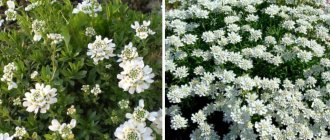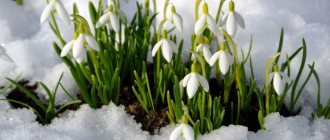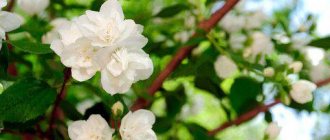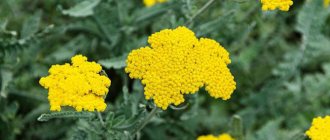September flowers - this is how gardeners affectionately call Aster virginiana or Novi-Belgii (the scientific name for September flowers is Symphyotrichum novi-belgii), since the flowering period begins in September. Inflorescences of snow-white, blue, lilac, cornflower blue, pink, and purple shades flaunt until late autumn.
So unpretentious that they grow like weeds
This representative of the Asteraceae family is native to North America. September flowers have taken root well in our area, quickly run wild and can grow without any care for decades. Lush flowering bushes can be found on the approaches to the taiga zone.
Septembers in the wild photo
The shape of the bush looks like an inverted pyramid. The stems are powerful, erect, well branched, densely covered with small leaves.
Huge variety of varieties
Perennial September asters have many faces: there are huge bushes about 2 m high and compact clumps barely reaching a height of 30 cm. At the end of August they are covered with numerous buds, and by mid-September the riotous flowering will take your breath away.
All the beauty lies in the huge number of corollas with a diameter of about 1-5 cm, collected in basket inflorescences. The leaves fall off, and the flowers can withstand temperatures as low as -50 °C. If warm weather returns, they will continue their beauty parade.
This unpretentious perennial will be a wonderful decoration for any corner of the garden.
Bloom
About 200 inflorescences open simultaneously on one bush. The corollas look like daisies: the core (yellow-orange, less often red or burgundy) is framed by a large number of narrow petals. The most common colors are lilac and purple.
Growing September flowers from seeds
September seeds from seeds, photo of seedlings
Seed propagation of September flowers involves growing seedlings. It is unlikely that you will be able to collect the seeds yourself - they do not have time to ripen, and if they reach the desired state, they quickly lose their germination capacity. Go to a flower shop for seed material.
- Start sowing September seeds in February.
- You will need wide containers or seedling boxes with a universal substrate.
- Plant the seeds to a depth of no more than 0.5 cm: it is enough to spread them over the surface of the soil, only lightly pressing them into the soil.
- Spray with a fine spray, cover with film or glass on top, maintain the air temperature in the range of 22-25 °C, and provide diffused lighting.
After 3-4 weeks, sprouts will appear, then the cover can be removed. During this time, do not forget to regularly ventilate the crops and maintain soil moisture by spraying. Water the seedlings moderately. If the sprouts are stretching, provide additional lighting. At the stage when two true leaves appear, plant them in separate containers.
After about 10 days of growth, feed with complex mineral fertilizers. From mid-April, start hardening the seedlings: take them out into the open air every day for 30-40 minutes. Transplant into open ground in May.
What difficulties arise during the growing process?
Even unpretentious plants can cause difficulties, September flowers are no exception.
Gardeners noticed that the seeds did not germinate well. Even if you follow agrotechnical recommendations, the probability of germination is minimal.
These flowers cannot be planted after nightshade, tulips, carnations, gladioli and gillyflowers. Difficulties with diseases and fungal infections may occur.
Without nutrients and mineral fertilizers, September flowers bloom small and the color becomes pale.
Otherwise the flower does not cause problems.
Vegetative propagation of September flowers
Dividing the bush is the most popular method of propagating September flowers. The procedure can be carried out in spring or autumn. Every 2-3 years, the bush is completely dug up, divided into parts (the division should contain part of the rhizome with 1-2 growth buds) and planted. The plant produces basal shoots - they can be planted annually. Carefully dig up from the edge of the mother bush and cut off the young plant with a sharp shovel.
After pruning, the side shoots can be used as cuttings. Root in water, roots will appear in about 20 days - you can plant them in open ground.
How to grow September flowers
New Belgian asters are unpretentious and require little care. For good growth and abundant flowering, they require sufficient moisture and periodic feeding. It is also necessary to take care of the root zone so that plants, especially young ones, do not become clogged with weeds.
Watering and fertilizing
Usually, New Belgian asters have enough atmospheric moisture and do not require additional watering, especially if the root zone is mulched. It is necessary to moisten the soil only during dry periods, but remember that excess water is harmful for flowers. For irrigation, it is better to use pre-collected water that has been heated during the day, and carry out the work itself in the evening, after the sun has gone down and the heat has subsided.
New Belgian aster does not require increased watering
Abundant flowering requires the presence of a large amount of nutrients in the soil, so it is necessary to feed New Belgian asters. In spring and autumn, humus is used for this, scattering it on the root zone. In early spring, you can feed the plants with ammonium nitrate. In the phase of bud formation and at the beginning of flowering, superphosphate and potassium sulfate are used to fertilize the soil.
When and how to prune September trees for the winter
Before wintering, all stems of the New Belgian aster are cut to stumps 2-3 cm high. This can be done immediately after flowering or after the first frost. To carry out the work, you can use a sharp knife or garden pruners.
How to cover a September tree for the winter
New Belgian asters do not require additional shelter for the winter. Adult plants are quite frost-resistant and can easily tolerate temperatures down to -34 °C.
For the winter, young asters are covered with a layer of fallen leaves or spruce branches.
Only first-year seedlings should be insulated, especially if they were planted in the fall. In this case, the root zone is additionally mulched with dry leaves, covered with a layer of spruce branches, and after the arrival of winter, covered with a thick layer of snow.
Planting and caring for September flowers in open ground
September in the garden photo
Site preparation
Site preparation must be done in advance. A couple of weeks before planting, dig to the depth of a spade and add organic matter (humus) and a complex of mineral fertilizers. Immediately on the day of planting, make holes the size of the root system, water well and let it soak. Then place the seedlings, add the missing amount of soil, and carefully press the soil with your palms.
How to plant
Keep a distance of about half a meter between individual plants. When planting along a path, the distance can be reduced to 20 cm. Plant September flowers separately from other plants, since the rhizome is capable of taking all the moisture from the area.
How to water
The first 10-14 days after planting should be watered about every other day so that the plants take root successfully.
Plants will not cause much trouble in caring for them; it is necessary to carry out basic procedures: watering, loosening the soil, feeding them with fertilizers, and carrying out sanitary pruning.
September flowers tolerate temporary drought well, and waterlogging of the soil can cause significant harm (disease damage). In principle, the plant can do without watering, but flowering will be sparse. Water approximately once a week in dry, hot weather; at average levels of temperature and air humidity, the interval is increased to 16 days. It is better to use warm water for watering.
Feeding
It is enough to feed 2-3 times per season. Use complex mineral fertilizers. Fertilize for the first time in early spring, focusing on the proportion of nitrogen; carry out the second feeding in mid-summer, introducing more potassium; the third can be carried out during budding or during flowering with a predominance of the phosphorus component.
Mandatory measures to maintain the plant in a healthy condition are regular loosening of the soil and removal of weeds.
Trimming
Sanitary pruning is carried out throughout the entire growing season: remove dried leaves and inflorescences, and also trim damaged or out-of-shape shoots. In the autumn, when the September flowers have faded, the shoots are cut off at the root, leaving stumps about 2 cm high.
September flowers, care
Agricultural technology and care includes the following steps.
Watering
After planting, the first two weeks the flowers need abundant and regular watering. The soil near the bush needs to be fluffed up, loosened, fed and weeded out.
In the future, when the root becomes stronger, you need to water it as needed. You can’t over-fill September trees with water, otherwise it will cause disease and lead to death.
During hot periods, experts recommend watering once every 14 days. To do this, it is better to use warm and settled water.
Top dressing
It is necessary to fertilize the soil a couple of times during the season. Minerals are used as fertilizer.
In the spring, the soil is fertilized with nitrogen, and in the summer with potassium.
During abundant flowering, phosphorus compounds can be added to the soil.
Trimming
This procedure is carried out to increase inflorescences. If dry leaves and wilted buds are found, they need to be cut off from the bush. Timely pruning allows you to create a well-groomed and attractive shape for the plant.
Transfer
After a few years, the aster’s root system sucks out all the beneficial substances from the soil. Lush bushes will not be able to continue to develop, and this will affect flowering.
It is advisable to replant September plants into new soil every spring; if this procedure is performed in the fall, there is a risk that the plant will die after winter.
Compliance with these requirements will allow the owner to enjoy the flowers for a long time.
When to replant September trees?
When to plant September trees is an important question. Aster virginiana bushes that grow in one place for a long time need to be transplanted. Over time, the soil becomes compacted and depleted, which prevents normal access of oxygen to the roots. Bushes tend to grow - continuous dense plantings will interfere with each other. The situation will be changed by replanting, which is carried out approximately once every 4 years (combine with dividing the bush).
As for the timing, it is preferable to do this in the spring: the bushes will have time to take root well and get stronger before wintering. If you replant in the fall, do it as early as possible - the plants should at least take root.
In the video, autumn planting of September flowers:
Why September flowers don’t bloom and what to do
The New Belgian aster may not bloom for several reasons. Most often this happens due to the wrong choice of planting method, when the plant is in the shade all day and simply does not have enough sunlight. In this case, only replanting the bush to a new location will help solve the problem. Another common reason for the lack of flowering on the New Belgian aster is overfeeding the plant with nitrates. Excess nitrogen fertilizers leads to an uncontrolled growth of green mass and a complete absence of flowers.
Diseases and pests
The plant has a fairly high resistance to diseases and pests.
Powdery mildew is a disease typical of all members of the Asteraceae family. If you do not react immediately, a strong and beautiful bush can wither at lightning speed. The disease is difficult to prevent: spores of the pathogenic fungus are transmitted by air, enter through water or hands, objects (gloves, garden shears) that have been in contact with diseased plants. The main symptom is the appearance of spots in the form of a whitish coating - it can be brushed off with your hand, like dust. After a while there are more and more of them. It is necessary to treat with a copper-based fungicidal preparation. For preventive purposes, treatment can be carried out with Bordeaux mixture or copper sulfate solution.
Other possible diseases: blackleg, fusarium, rust. Treat with a fungicide (foundazol, quick, previkur, etc.).
Pests: meadow bugs, spider mites, aphids, earwigs, cutworm butterflies. Apply insecticide treatment. Sometimes you can find slugs - they are collected by hand or using special traps.
Answers to readers' questions
What is the lifespan of a plant?
September women are among the top ten among centenarians. They can grow as long as they want if good conditions are provided and protection from harmful insects and infections.
Flower care in winter.
Trim drying bushes to the ground, cover young plants with spruce branches, and leave mature ones open.
As summer comes to an end and gives way to the inevitable autumn with its splendor of yellow and orange tones, you want to prolong the joy of contemplating flowering plants in your garden a little. The completely unpretentious September flowers, which in fact are nothing more than a perennial variety of Virginian or New Belgian aster, can help do this. A distinctive feature of this garden crop is its late flowering, which may not begin until late August or early September. It was this circumstance that gave rise to the name of the September flower. We invite you to learn more about how to plant and care for September flowers in your garden, when to properly replant, water and loosen the soil.
September in landscape design
September in landscape design photo
September flowers give their beauty at the end of summer, not afraid even of the first cold snaps and the sudden fall of the first snow.
September in garden design photo
These unpretentious perennials are welcome guests in the garden. Bushes with delicate inflorescences look great in single and group plantings; they are used to frame garden paths, borders, and the base of bushes (on the south side).
September in landscape design photo
They look great in a mixborder with their family members. Neighbors can be hardy, drought-resistant plants, for example, chrysanthemums, rudbeckias, anemones.
Unpretentious September autumn flowers
The many-sided September-October flowers will be appropriate anywhere in the garden because of their discreet beauty and long, late flowering, when other residents of the garden have long since retired
It is only important to choose the right asters in height and then it will be possible to create a mixed mixborder from asters alone, although plantings with other flowers are also very beautiful. Last year, after reading that they are frost-resistant, I left one bush outside
She wrapped it in straw and dry leaves, dug up two bushes, put them in pots and put them in the cellar. The one that spent the winter outside did not even come out in the spring, but shoots sprang up in the cellar. Not every winter is snowy.
Over the summer, the bushes double in width. Amazing September flowers are not afraid of frost and produce new shoots in the spring. By dividing the bushes in autumn or spring, September flowers are propagated. If watering is infrequent, the bushes will be shorter. Perennial asters bloom amazingly. For now, crimson September flowers are still exclusive in our gardens. September flowers are one of the latest flowers in the garden, delighting us with their bloom when yellow leaves are already falling from the trees.
It is not for nothing that perennial asters are also called September asters, October asters and even November asters - they delight with their small but lush flowers until late autumn, right up to persistent frosts. The perennial aster is a tall plant, up to 200 cm high. There are compact, low varieties. The flowers can withstand partial shade, but grow better in sunny areas. They quickly lose their germination capacity and do not always ripen on the bush. Perennial aster bushes can be divided in both spring and autumn. It is advisable to provide the flower with watering during budding.
Bush aster (Aster dumosus, Symphyotrichum dumosum). See photo of the bush aster in my garden below. From my own experience I will say that this is one of those plants that you remember when it begins to bloom, the shrub aster is so unpretentious. Aster Frikartii (Aster × frikartii) is a hybrid of the Italian aster and Thomson's aster. It is believed that Frikart asters took the best features from both parents: large flowers, long flowering from mid-summer to mid-October and unpretentiousness.
Aster Novobelgian - can be of different heights depending on the variety. The leaves of the New Belgian aster are devoid of pubescence. Aster New England is taller than New Belgian, the bush is more powerful and spreading, it has more leaves and flowers. Bushes of this variety take longer to grow.
The best September varieties with photos and names
There are many varieties of Aster virginiana, let's look at some of them.
Dwarf varieties (about 40 cm high):
September variety Audrey Symphyotrichum novi-belgii Audrey photo of flowers
Audrey – lilac-pink color;
September Jenny Symphyotrichum novi-belgii Jenny photo
Jenny - miniature bushes with red inflorescences;
September Snowsprite Symphyotrichum novi-belgii Snowsprite photo
Snowsprite - a bush decorated with snow-white inflorescences.
Medium height varieties:
Elina - bushes about 80 cm high fascinate with lush flowering, corollas reach a diameter of 5 cm, the color is bright pink.
September Cassie
Cassie - the height of the bush is 85 cm. Snow-white corollas with a diameter of about 3 cm form a continuous covering.
September Aster novi-belgii 'Winston S. Churchill' photo
Winston S. Churchill - plant height is limited to 70 cm. Ruby-colored flowers.
September Royal Velvet Aster novi-belgii 'Royal Velvet'
Royal Velvet – the color is purple with a bluish tint, the bush seems to glow.
Tall varieties
Reach a height of 1 m or more, the diameter of the corolla is 3.5-4 cm:
September White Ladys Symphyotrichum novi-belgii White Ladys photo
White Lady - the height of the bush is 1.1 m. The inflorescences are snow-white with a yellow core.
September Lady in Blue Aster novi-belgii Lady in Blue photo
Desertblue – blue-lilac color scheme of inflorescences.
Dastyrose - flowers of a soft crimson hue.
Amethyst - semi-double inflorescences, dark purple petals.
September Dick Ballard Dick Ballard photo
Dick Ballard – soft pink petals arranged in 2 rows.
Description of the September flower
It is known that the New Belgian aster first came to the territory of modern Europe in the 17th century; it was brought from China to France. Gradually, the cultivation of these flowers began in other countries, including in Russia, where they were called September or October flowers for their late flowering. People also find another name - Michaelmas chamomile, since these plants bloom on Michaelmas Day (September 19).
Queen of the autumn garden - New Belgian aster
The main characteristics of the New Belgian aster are presented in the table:
| Parameter | Meaning |
| Plant type | Perennial herbaceous shrub |
| Escapes | Smooth, bare or fleecy, depending on the variety, straight or slightly curved, forming a reverse pyramidal bush up to 1.5 m high |
| Leaves | Sessile, alternate, lanceolate, green, rather small |
| foliage | Strong, especially in the upper part of the shoots |
| Root system | Fibrous rhizome |
| Flowers | Bisexual, tubular in the central part, ligulate along the periphery, collected in numerous inflorescences-baskets, color depends on the variety |
| Flowering time | September-October, some varieties bloom earlier |
When and how does the New Belgian aster bloom?
As a rule, the flowering of the New Belgian aster begins in the last ten days of September and ends in early October. These terms are typical for the Moscow region. In other regions they may differ slightly in one direction or another. Some varieties and hybrids bloom much earlier; the first inflorescences may appear on them as early as July.
Up to 200 inflorescences can bloom on a New Belgian aster bush
At the same time, up to 200 flowers can bloom on the New Belgian aster, which can occupy up to 50% of the surface area of the bush. At such times, the plant looks especially impressive.
What colors are September flowers?
The native color of the petals of the New Belgian aster is purple. It is this that most often occurs on wild and semi-wild plants, which are found in abundance in areas close to housing. Among the many varieties of September flowers, there are species with reed flowers of various shades of blue, blue, violet, pink, red, yellow. The central part is most often painted yellow or light green.
Aster virginiana
Aster Virginian or New Belgian is a fairly unpretentious plant brought to us from the eastern regions of North America. It grows everywhere, right up to the taiga zone and is most often known to us by the name “September”.
This rhizomatous perennial grows in the form of a bush, characterized by an inverse pyramidal shape. The stems of Virginia aster reach a height of 50-150 cm; in the upper part they can be densely branched, hairy or bare, all depending on the variety. The bushes are most often densely leafy. The leaves have a linear-lanceolate shape, with blunt bases.
The inflorescences are quite large, paniculate, and can consist of 200 baskets, the diameter of which is 2 cm. Reed flowers most often have a purple color. In some varieties, reed flowers are arranged in several rows, covering yellow tubular flowers, thereby achieving a double effect.
This type of perennial autumn flowers, with proper care and optimal soil conditions, can bloom very profusely and for a long time, from September until frost.
Aster virginiana prefers places well lit by the sun, protected from cold winds. This plant is quite frost-resistant, but it is best to plant it in a permanent place in early May.
Pre-cultivate the soil to a depth of 25 cm. The feeding area must be calculated individually, depending on the height and degree of bushiness of the aster. An area of 20 x 25 cm is enough for low-growing varieties, while tall varieties need more space - 40 x 45 cm. Aster virginiana grows quite quickly, since it has a long rhizome, so it can be replanted after 3-4 years.
In addition to dividing the bush, methods of propagating this plant such as cuttings and sowing seeds are used. However, they are much more labor-intensive and ineffective. In some cases, you can divide an aster bush without digging it up, but simply separating 1-2 parts from it using a sharp shovel. Fill the vacated holes with fertile soil and water.
Caring for the plant involves maintaining the soil in a fairly loose state, removing weeds and watering in dry weather (slightly warmed in the sun, not cold water). In addition, the Virginia aster needs periodic feeding, so do not forget to apply mineral fertilizers to the bush from time to time. Also, every year in the fall or after cutting the stems in the spring, it is necessary to add compost under the Virginia aster.
This rather popular type of perennial is susceptible to diseases typical of all asters. Powdery mildew is especially dangerous for Virginia aster, which is why breeders are trying to develop varieties that will be more resistant to this disease. And you can fight this disease of asters with the help of any copper-containing preparations.
September inflorescences are often used as cut flowers to create a variety of bouquets and compositions. A cut flower retains its decorative qualities for up to 10-15 days, subject to systematic replacement of water and removal of leaves from the submerged part of the stem (to avoid rotting). You can also dip a silver coin in water to keep it fresh longer. To feed the cut plant, place 1 tsp in a vase with it. granulated sugar, a crystal of potassium permanganate or an aspirin tablet.
As a beautifully flowering ornamental plant, the New Belgian aster is often used for various flower plantings against the background of the lawn. Groups of bushes can be used as a background. Try not to plant asters together with small perennials, since the New Belgian guest will quickly displace its weaker “neighbors”.
To date, many interesting varieties of New Belgian aster have been bred. Here are the 2 most common ones:
"Amethyst". This plant reaches a height of up to 100 cm. Flower baskets are semi-double, reed flowers are arranged in 5-6 rows and are dark purple in color; tubular - light yellow in color. Flowering duration is 30-35 days.
"Ballard." A very ornamental plant, reaching a height of up to 100 cm. Flowering is abundant, the diameter of the inflorescences is up to 3 cm. The reed flowers are bright pink in color.
Very often, this variety of New Belgian aster is used for various arrangements and bouquets. The plant looks great both in group plantings and massifs, and alone - against the backdrop of various shrubs.
| Next > |
September flower care
September flowers, the care of which is a very important point in their life, must be carried out taking into account a number of rules that both a professional and an ordinary gardener can handle. You can use any soil, the main thing is that it is not rocky and does not contain metals. September flowers love light and tolerate frost and dryness well. In order not to disturb the naturally formed crown, there is no need to trim the September flower. Dense stems make the shrubs look clear and beautiful, and do not require additional adjustments.
Late September flower can be transplanted at any time of the year
Reproduction
September flowers can be propagated by dividing the bush. This should be done in the spring
It is important that there are some buds on each part. Plant the September flower in well-dug soil, to a depth of 20-25 centimeters, water and fertilize
Thanks to the intensive root system, the September flower acclimatizes and expands quite often. The optimal distance between bushes is 40 centimeters.
Another propagation method is the use of seeds. Under natural conditions they do not have time to ripen, so you can buy September flowers and its seeds in a specialized store.
You can propagate September flowers by taking cuttings. They need to be placed in water for 20 days, and then planted in moist soil.
September flowers - a scattering of fireworks in the garden
Watering and fertilizing
The September flower does not need frequent watering. This representative of nature can withstand drought, but moderate drought. If necessary, if the weather is too dry, you can still resort to additional humidification.
September flowers will be rewarded for fertilizer with a beautiful appearance that decorates the local area. For this purpose, you can use organic or mineral products in dry or liquid form.
If there is an excess of feeding, September flowers, the care of which is not burdensome and simple, will grow faster, and therefore age.
September flower - a farewell chord on the eve of winter











